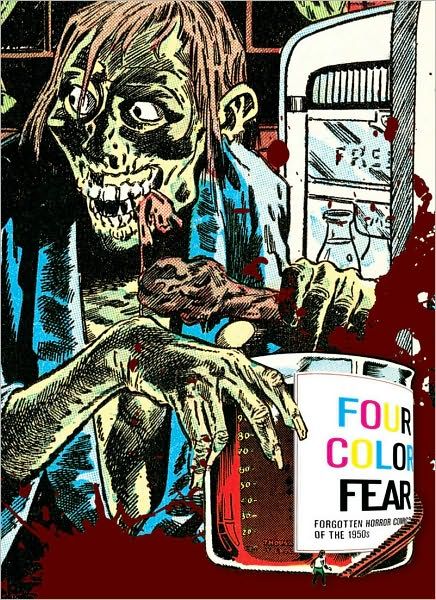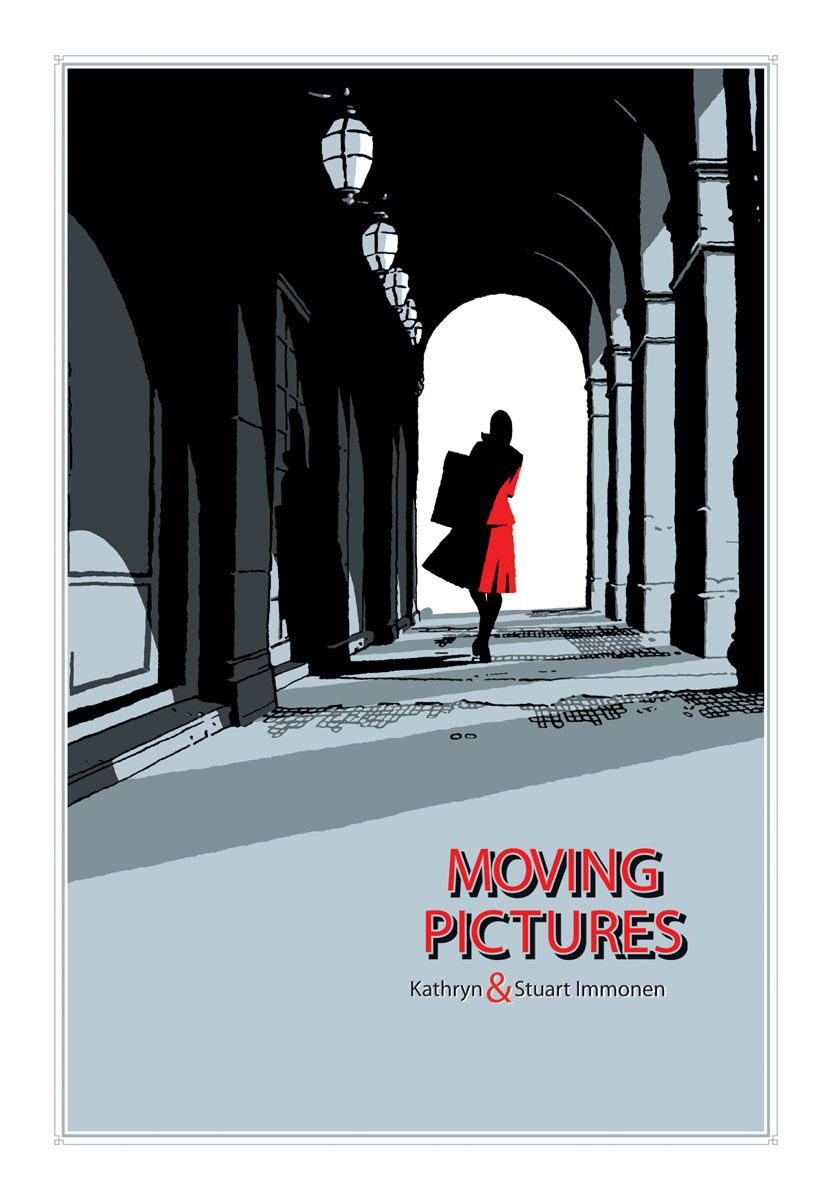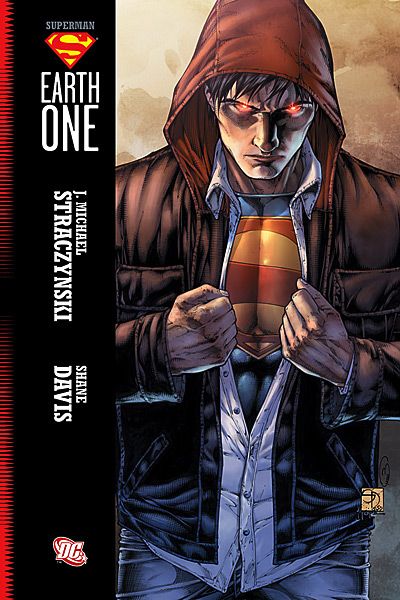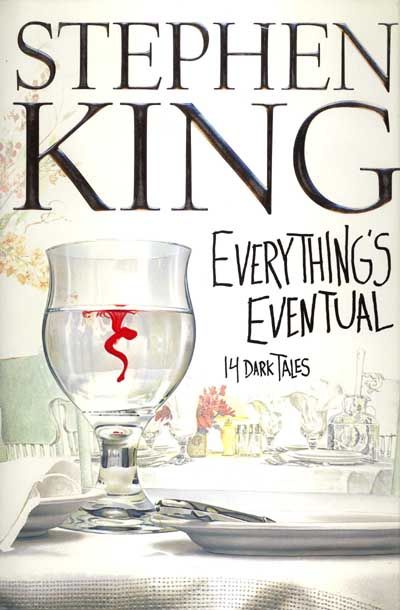Welcome to another spook-tacular edition of What Are You Reading? Our special guest this week is writer Sam Costello, who operates and writes horror comics for the site Split Lip. If you're looking for some spooky stories to read tonight, it's a good place to start.
To see what Sam and the rest of the Robot 6 crew have been reading lately, click below, if you dare ...
*****
Brigid Alverson
I really am liking the art in Kathryn and Stuart Immonen's Moving Pictures, but I'm halfway through the book and still not quite sure what is going on. I get the basics of what people are doing, but the story is elliptical enough that their relationships seem to be just beyond my grasp. The elegant black-and-white style is compelling, and the panels all seem to be composed of geometric shapes that fit together like some futuristic device from the 1930s, at once abstract and concrete. It's a demanding book, but I'm enjoying the challenge of reading it.
I know I'm late to this particular party, but I have been reading David Hajdu's The Ten-Cent Plague with great fascination. I was expecting a straightforward narrative but what's interesting to me is the way the story waxes and wanes—public criticism of comics builds and then fades, only to build again. One of the most interesting aspects, to me, is Hajdu's interviews with people who took part in comics-burnings. It's a fascinating reminder that human events are often more complex than they seem—the book-burners often acted out of genuine concern, but the youngsters who participated often felt very mixed emotions, both before and after the burnings—and most went back to comics.
Chris Mautner
This week I read the much ballyhooed Superman: Year One. It was ... alright. There certainly were a number of pitfalls a revamp project like this could have easily taken and it manages to avoid most of them. Writer J. Michael Straczynski doesn't embarrass himself the way he seems to be on the monthly Superman book (based on what I'm hearing, I mean, I haven't actually read the comics in question). His basic answer to the question of "how do you make Superman relevant for a modern audience" by increasing his insecurity and "alien" feeling, and playing up the sci-fi angle a bit more. There's a nice twist regarding Kal-El's origin that comes to the fore midway through, which I appreciated, and I was glad to see Straczynski didn't feel the need to include every aspect of the mythos, like, say, Lex Luthor, immediately. (Honestly, I might have liked the book more if he had taken even more chances. What would a Superman without Jimmy Olson or the Daily Planet, for example, be like?)
All the same, I don't feel I can really recommend this book. Part of my problem is I really just don't care for Shane Davis' art work -- it's part and parcel of that current trend of overly detailed, stiff, heavily photo-referenced comics where the characters look like they're models posing for a picture rather than people interacting with their environment. Straczynski's dialogue, while occasionally ringing true, seemed more concerned with being clever and cute than with creating words and phrases that sound like things people -- even superheroes -- might actually say. I suppose the bottom line is it struck me as a rather bland Superman story that didn't engage me very much despite the occasional bright idea. It's certainly not going to replace All-Star Superman as my "recommended comic for Superman newbies" anytime soon.
DC also sent me copies of two comics that will be out in stores next week: Batman & Robin #16 and Superboy #1. B&R #16 was fun, a relatively satisfying ending to Morrison's run on the series that also manages to set things up nicely for the upcoming Batman Inc. Frazier Irving's art is easily the best thing in the issue (Cameron Stewart and Chris Burnham also filling in handily) -- his work remains one of the highlights of the series. While #16, like the B&R series as a whole, doesn't come anywhere near Morrison's best work, it's an enjoyable little comic nevertheless that I think will satisfy folks who have been following the series.
As for Superboy #1, I really don't know what to say yet. The issue sped through so quickly (Superboy meets the Phantom Stranger, talks to his mom, fights the Parasite, the end) that it felt like it was over before it had even started, a common problem in mainstream comics these days. I suppose writer Jeff Lemire and artist Pier Gallo have enough on the ball to make a fun, engaging superhero comic, which seems to be their goal, but honestly, the only thing I can say about the first issue is it failed to make any sort of impression on my whatsoever.
Michael May
I'm working hard at getting through all the collected volumes (so far) of BPRD before Halloween. As of this writing, I'm almost done and am convinced that there's no better horror comic in existence. Not that I'm THAT widely read, but I don't know how it's possible to beat the strong characterization and drama, the creepy chills every few pages, the awesome creature designs and storytelling by Guy Davis, and the insanely entertaining plots featuring giant robots, ancient mummies, Nazis, secret societies, elder gods, mole-people (who, by the way are teaming up with the frog-people), Victorian cyborgs that look like mutant deep sea divers, vampires (the scary kind), were-creatures, creepy little demon-possessed girls, Wendigo, and a Moreau-esque island full of bizarre hybrid-animals. I'm going to be very sad when I reach the end and have to wait for the next volume.
Tim O'Shea
Missed out on last week's column, so some catching up at first. The best part of Jeff Parker and Gabriel Hardman's Hulk #26 (other than Hardman's solid sense of panel design) is Parker's use of Bruce Banner as a supporting cast member in the book.
My one complaint about Jen Van Meter and Javier Pulido's Black Cat miniseries, which ended with issue 4 last week? It was a miniseries. Here's hoping editor Steve Wacker can concoct a way for this creative team to a sequel miniseries sometime in the near term. As solid a grasp as Van Meter had on the lead character (only exceeded in quality by Pulido's gymnastic renderings of Felicia) she made the book an equally engaging read thanks to the miniseries' supporting cast.
As for this week, Jonathan Hickman and Steve Epting give readers a far different Ben & Johnny focused tale in Fantastic Four #584, where the two heroes go out for a day and night on the town. Marvel has given Hickman the keys to the FF universe and he is relishing the chance to shake up the status quo (in the run-up to the upcoming Fantastic Three storyline). His present day tweaking of the Yancy Street Gang has even been impacted by tough economic times in a darker way than some might expect. Another element of this particular issue is just how much Epting loves to draw present day cities. Don't ask me why, but his recent work in Captain America may have been mostly set in New York
(and was solid enjoyable work), but for the Fantastic Four he seems better able to almost go cinematic in his layouts, making greater use of skyscrapers for incredible backgrounds
Sam Costello
I didn’t plan that I’d only be reading collections of short pieces this week. But there it is, and I suppose it’s fitting for someone who primarily writes short comics himself. If I were writing this in another week or two, I might well have novels, graphic and otherwise, on the list but, for now, it’s all the art of the short.
The art starts with a long book: Everything’s Eventual, by Stephen King. I haven’t read King’s novels in many years—I generally don’t like most horror novels; things often scare me more when they’re shorter, more distilled—but I enjoy his short stories. “The Road Virus Heads North,” a story about a haunted painting whose subject is inexorably stalking the writer who’s just bought it at a yard sale, is a particular favorite.
Despite being non-fiction, some of the stories in The Best American Crime Reporting 2010, ed. Otto Penzler and Thomas H. Cook are no less chilling. This anthology of the best crime non-fiction published in American magazines. Each story varies in subject and tone, but they all share fantastic reporting. The relentless parade of misery—from murder to financial fraud, sex crimes to kidnapping—can make it tough going, but I appreciate good journalism and true crime writing, and look forward to this anthology every year.
Continuing with magazines, I’m just beginning to wade into The Believer #75. The Believer is perhaps my favorite magazine thanks to its breadth and depth. Essays, interviews, comics, and columns on books, film, comics, and all other kinds of work make each issue, from lit-journal stars McSweeneys, a sure bet to expose me to new ideas and art, which I find vital.
How could it be Halloween without some horror comics? I’ve been enjoying Four-Color Fear, ed. Greg Sadowski, an anthology of ‘50s horror comics from publishers other than EC. I’m only a couple of stories in and, while none have actually scared me, the oversized, full-color book looks to be a wonderful primer on horror-comics history.






